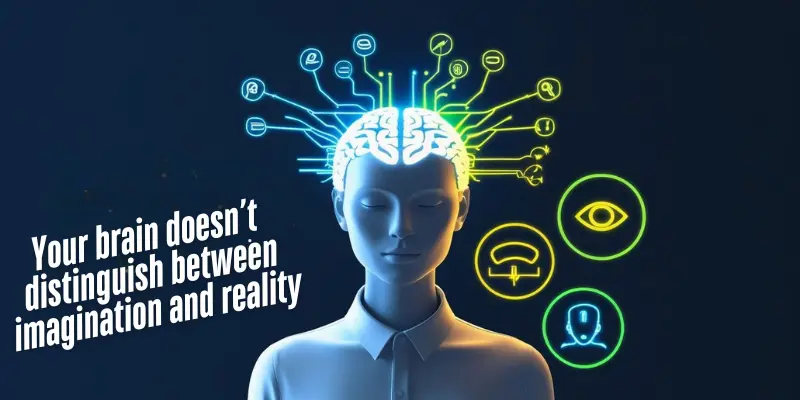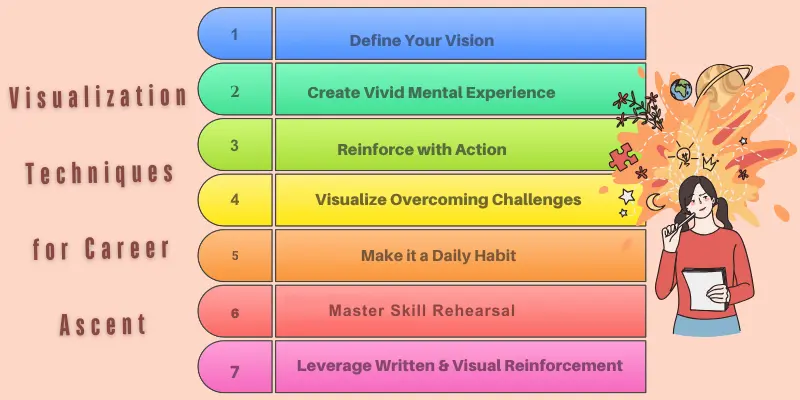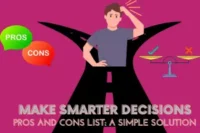7 Powerful Visualization Techniques to Land Your Dream Job Faster
Published: 14/06/2025
Imagine this: Michael Phelps, the most decorated Olympic swimmer of all time, credits much of his success to visualization. Every time he dives into the pool, he mentally rehearses every stroke, turn, and breath before the race even begins.
This practice has been a core part of his routine, enabling him to push through moments of doubt and deliver performances under pressure. What if you could use a similar technique to achieve your career dreams?
Visualization is a powerful, scientifically-backed tool used by top performers across various fields—athletes, CEOs, artists, and entrepreneurs. It’s not just about imagining success; it’s about creating a mental roadmap that makes your goals feel tangible, attainable, and real.
While many dismiss it as “wishful thinking,” research proves otherwise. In fact, psychological studies show that visualization can actively rewire your brain, improving focus, confidence, and overall performance.
But here’s the reality: many of us face career struggles that seem hard to overcome. You might be feeling stuck, unsure of how to take the next step. Maybe there’s a lack of confidence, or you’re constantly battling imposter syndrome. The path forward feels unclear, and your professional growth seems like it’s on pause.
This article aims to help you break free from these challenges by providing a step-by-step blueprint for using visualization techniques to reach your career goals—whether it’s landing your dream job, getting that promotion, or simply gaining the confidence to excel in professional settings. Consistency and personal growth are the keys to transforming your aspirations into reality. It’s time to see your success and make it real.
Understanding the Power: How Visualization Rewires Your Career Path
Visualization is more than simply picturing an outcome in your mind. It’s a holistic mental practice that involves creating vivid, multi-sensory images of your goals and the journey to reach them. Imagine yourself succeeding—feeling the excitement, hearing the applause, or even experiencing the sense of accomplishment.
It’s about immersing yourself in these experiences and creating a clear mental image that touches on all five senses. The more detailed and realistic your visualization, the more powerful it becomes.
Visualization isn’t just about wishful thinking or daydreaming; it’s an intentional mental exercise where you engage deeply with the process. When done correctly, it helps you clarify your goals, making them feel more attainable and within reach.
A crucial part of this practice is the mindset behind it. To truly benefit from visualization, you need to quiet the negative self-talk that often holds you back. Replace doubts and fears with positive affirmations and strong belief in your ability to succeed. This shift in mindset is key to making your goals feel real and achievable.
All that we are is the result of what we have thought.Buddha
The Science Behind It: Your Brain’s Secret Weapon
Our brains are powerful, and research shows that visualization activates the same neural pathways that are used during actual performance. For example, when you vividly imagine practicing for an important presentation, your brain doesn’t distinguish between the mental imagery and the real experience. It activates similar brain regions as if you were actually giving the presentation.
This means that by visualizing success, you’re essentially training your brain and body to perform better. It’s like a rehearsal for your mind, preparing it for real-life challenges.

Visualization also helps improve focus and confidence. When you engage in this practice, your brain learns to focus on the desired outcomes, blocking out distractions and filtering out negative thoughts.
This process reduces anxiety, helps manage stress, and improves your ability to stay present in high-pressure situations. It’s like building mental muscle—each time you visualize success, you grow stronger mentally, making it easier to handle future challenges with calm and confidence.
Empirical Evidence
Visualization isn’t just a theory; it has been proven effective through research and real-world applications. For instance, athletes use mental imagery to enhance muscle strength and improve performance. Studies have shown that simply visualizing physical exercise can stimulate the same muscles as actual workouts, contributing to muscle growth.
Surgeons also use visualization to improve their precision during complex procedures, reducing stress and enhancing their focus. By imagining themselves successfully completing the surgery, they mentally rehearse each step, which leads to better performance in the operating room.
Even stroke victims have benefited from visualization practices. Using the principles of neuroplasticity, which refers to the brain’s ability to rewire itself, stroke patients have used mental exercises to retrain their brain, improving mobility and regaining lost functions.
Why It’s Crucial for Your Career Success
Visualization is more than just a mental tool—it directly impacts your career success. Whether it’s preparing for a presentation, an interview, or an important meeting, visualization boosts your confidence and keeps you focused on the desired outcome.
When you visualize yourself performing well in these situations, your brain becomes conditioned to expect success, making it easier to approach challenges with confidence. It helps you overcome fear, manage stress, and perform under pressure, leading to better results in both professional and personal scenarios.
Visualization is especially helpful for addressing specific career challenges:
- Gaining clarity: When you visualize your ideal career path, it helps you see the steps you need to take and provides a clearer vision of your goals.
- Overcoming imposter syndrome: Visualization helps build confidence and reminds you of your capabilities, reducing self-doubt and reinforcing that you deserve success.
- Navigating difficult conversations: By visualizing how a conversation will go—whether it’s a negotiation or conflict resolution—you can mentally rehearse and improve your approach.
- Enhancing overall professional well-being: Visualization isn’t just about career achievements. It helps reduce stress, improve mental health, and create a sense of accomplishment as you visualize success in various aspects of your professional life.
When you integrate visualization into your daily routine, you’re not only preparing for success—you’re actively shaping your career and your mindset for the future you want.
Your Step-by-Step Blueprint: Proven Visualization Techniques for Career Ascent
This section will guide you through actionable steps to harness the power of visualization and drive your career success. Follow these clear, practical techniques to achieve your goals and unlock your full potential.

Step 1: Define Your Vision with Crystal Clarity
Without a clear vision, your efforts will be scattered, and results will be vague. To make visualization effective, clarity is key. The more specific and measurable your goals, the more your mind can work towards achieving them.
Actionable:
- Start by defining your ideal career or success in detail. Imagine your dream job, promotion, or project completion. What does success look like? Feel like? Sound like?
- Break your larger goal down into smaller, more manageable steps. This is called process visualization. Focus on the journey, not just the end result. For example, if you want to land a promotion, visualize not just the day you get promoted, but also the smaller steps—meeting deadlines, leading meetings, learning new skills, and seeking feedback—that will get you there.
Setting goals is the first step in turning the invisible into the visible.Tony Robbins
Step 2: Create a Vivid Mental & Sensory Experience
Engaging all five senses during visualization makes it real and impactful. The more sensory details you include, the stronger the neural connection and the more powerful your visualization becomes.
Actionable:
- Find a quiet, distraction-free space to practice your visualization. This will help you fully immerse yourself in the experience.
- Use guided imagery or meditation if you’re new to the practice. Many apps or online videos can guide you through the process, helping you stay focused.
- Imagine not just the visual elements, but also the sounds, smells, physical sensations, and emotions (like pride, excitement, or accomplishment) associated with achieving your goal. The richer the experience, the more your brain will connect to it. The feeling of your hands shaking before a big presentation, the sound of applause after a successful pitch, the scent of a celebratory drink—these details make the visualization much more powerful.
Step 3: Reinforce with Consistent Action & Affirmation
Crucial Point: Visualization complements action, but it doesn’t replace it. Visualization alone won’t get you results; consistent action is just as important.
Actionable:
- Develop a concrete action plan that breaks down your visualized goal into daily or weekly tasks. For instance, if your goal is to get a promotion, your action steps might include improving skills, networking, taking on leadership roles, and requesting regular feedback.
- Combine visualization with positive affirmations. As you visualize your success, affirm to yourself, “I am capable,” or “I am achieving my goals.” Repeating these positive statements enhances self-belief and reinforces the mental imagery.
- Track your progress and celebrate even the small wins. Each step forward builds momentum, making the ultimate goal feel more achievable.
The best way to predict the future is to create it.Peter Drucker
Step 4: Visualize Overcoming Challenges (The “Fear-Setting” Technique)
Preparing for potential obstacles helps you develop resilience and reduces anxiety. Visualization is a great way to mentally rehearse handling difficulties, so you feel more in control when they arise in reality.
Actionable:
- Visualize situations where you might face challenges—whether it’s a tough negotiation, a project setback, or a difficult conversation with a colleague or client. By mentally walking through these tough scenarios, you’ll be prepared to handle them with confidence.
- See yourself dealing with these challenges calmly and professionally, learning from the experience, and coming out stronger. This practice allows your mind to work through these situations, so they don’t seem as intimidating when they happen in real life.
Step 5: Make it a Daily Habit: Practice & Refinement
Visualization is a dynamic process that requires regular practice to become effective. The more consistently you practice, the stronger the mental connections become, helping you stay focused on your goals.
The transformative power of visualization truly unfolds when it becomes an ingrained part of your daily routine. As the ancient philosopher Aristotle wisely stated:
We are what we repeatedly do. Excellence, therefore, is not an act, but a habit.Aristotle
Actionable:
- Dedicate a specific time each day—like 10 minutes in the morning or before bed—to your visualization practice. This will help make visualization a routine part of your life.
- As your goals evolve, adapt your visualizations accordingly. Visualizing overcoming a challenge today might look different than visualizing the promotion you want to achieve next year. Adjust your mental imagery as your aspirations and circumstances change.
- To make the process even more powerful, consider using vision boards, index cards, or journaling to reinforce your visualizations. Visual reminders will help keep your goals front and center, making it easier to stay on track.
By following these steps, you’ll not only create a clear vision for your career but also actively work toward it with confidence and purpose. Consistency, along with visualization, will keep you focused and motivated, helping you reach your goals faster. Keep practicing, and trust the process—your future success begins in your mind.
Step 6: Master Skill Rehearsal for Peak Performance
Mental rehearsal is an incredibly powerful tool for improving specific career skills and ensuring you perform at your best when it matters most. Whether you’re preparing for a high-stakes presentation, a tough negotiation, or a challenging client call, rehearsing in your mind can significantly boost your confidence and ability to execute effectively. By practicing mental imagery, you create a mental roadmap for success, enabling you to react calmly and effectively in real-world situations.

Actionable Steps:
- Identify Specific Career Skills to Improve: Start by choosing one or more career skills you want to develop. For example, this could be:
- Public speaking: Maybe you’re preparing for a big presentation or an industry conference.
- Negotiation: Perhaps you’re working on securing a deal or managing tough conversations with clients.
- Client calls or meetings: These could be phone calls where you need to discuss a new project, handle objections, or close a sale.
The first step is to define the skill you want to improve and the situations in which you need to use it. This focus helps make the visualization specific and actionable.
- Vividly Visualize Performing These Skills Flawlessly: Once you’ve identified the skill, visualize yourself performing it flawlessly. Imagine yourself speaking with confidence during a presentation, responding to client concerns smoothly in a meeting, or negotiating with calm determination. Engage all five senses in your mental imagery:
- What does the room look like? Visualize the setting.
- What do you hear? Picture the sounds around you, like your voice or the responses of others.
- What do you feel? Feel the emotions of confidence, excitement, or calm as you handle the situation successfully.
- What do you smell or taste? If relevant, imagine the scent of the room, the taste of water or coffee during a meeting—every detail makes the visualization more real.
By vividly imagining yourself succeeding in these situations, your brain becomes better prepared to handle them when they happen in real life.
- Mentally Rehearse Different Scenarios, Including Challenges: Visualization isn’t just about imagining success. Mentally rehearse potential challenges that may arise and how you would navigate them. What if a client objects to your proposal? How will you manage unexpected questions during a presentation? Visualize yourself handling these scenarios calmly and confidently, showing resilience and adaptability.
For example, in a negotiation, imagine that the other party is hesitant. Visualize yourself responding with poise, offering solutions, and finding common ground.
In a public speaking situation, imagine a technical difficulty—how do you recover and continue without missing a beat? By rehearsing these potential challenges, you mentally prepare yourself for the unexpected, reducing anxiety and improving your overall performance.
By consistently practicing mental rehearsal for specific skills, you not only improve your ability to perform but also build unshakeable confidence for high-pressure situations. It’s like doing a dry run for your career, where every performance gets better and more natural. This technique helps you stay calm, collected, and ready for anything, giving you the edge in professional settings.
Step 7: Leverage Written & Visual Reinforcement
Externalizing your vision through writing or visual aids is a powerful way to deepen your engagement with your goals. Reinforcement is key to keeping your vision alive and motivating you to take action. Written and visual tools provide a tangible reminder of your goals and allow you to interact with them on a daily basis. This is especially helpful for those who are visual or kinesthetic learners, as it brings your mental imagery to life and connects it to the real world.
Actionable Steps:
- Written Visualization: Take time each day to write a detailed narrative of your desired future outcomes. This could be a vision of your career five years from now, your next promotion, or even your ideal workday.
- Describe the scene in vivid detail. Where are you? What does the room look like? What are you wearing? What are others doing?
- Engage all five senses: What do you hear? What can you smell? What does success feel like physically (e.g., shaking hands with a new client, feeling the weight of a promotion certificate)?
- Emotions are key: Write about how you feel in that moment of success—excited, proud, or fulfilled. By writing this out as if it has already happened, you allow your mind to start believing in the reality of the vision.
- Vision Boards: Create a physical or digital collage that represents your career goals. This could include:
- Images, quotes, or symbols that resonate with your aspirations.
- Place your vision board somewhere visible—on your wall, desk, or as your phone background—so you can see it every day. This constant reminder helps reinforce your mental imagery and keeps your goals front and center in your mind.
- Index Cards: Write specific goals or affirmations on index cards. These could include personal affirmations like, “I am confident in my abilities,” or goal-focused statements such as, “I am on track for a promotion in six months.”
- Keep these cards somewhere accessible—your wallet, desk, or nightstand—and review them regularly. Each time you read a card, pause for a moment and visualize yourself achieving that goal or feeling the emotion tied to that affirmation.
By combining written and visual reinforcement with your daily routine, you create a consistent, immersive experience that keeps your goals alive in your mind. This approach helps transform your aspirations from abstract concepts into tangible, achievable outcomes, ensuring you stay motivated and focused on your path to success.
Real-World Impact: Inspiring Success Stories & Expert Insights
Visualization isn’t just a technique used by athletes. In fact, it’s been applied by professionals across various industries to achieve remarkable career success. Let’s explore a few inspiring stories where visualization has helped individuals overcome challenges and reach their career goals.
- Anna’s Journey from Burnout to Director: Anna, a marketing manager, was feeling overwhelmed and burned out after years of juggling multiple campaigns and tight deadlines. She had lost her passion for the job and was on the verge of quitting. That’s when she started practicing visualization. Every morning, Anna would close her eyes and visualize herself in a leadership role, guiding teams with confidence and making impactful decisions. She vividly imagined herself overcoming the stress of her workload and excelling in her career. Over time, her mindset shifted, and she began to approach challenges with renewed energy and clarity. Within six months, Anna was promoted to Director of Marketing, a role she had previously felt was out of reach.
- John’s Path to Public Speaking Success: John, a software engineer, had always struggled with public speaking, which made him anxious about presenting to clients. He started using visualization to prepare for these presentations, imagining himself confidently explaining complex technical concepts to clients and receiving positive feedback. By visualizing himself handling difficult questions and presenting his ideas clearly, he reduced his anxiety. Eventually, John’s presentations improved dramatically, leading to more opportunities and recognition within his company. He is now often called upon to lead client meetings and share insights at industry conferences.
These examples show how visualization can help you see beyond the obstacles and imagine a path toward success, whether you’re aiming for a promotion, overcoming burnout, or mastering a new skill.
Expert Perspectives
Visualization has been backed by psychologists and career coaches, who emphasize its role in shaping motivation and fostering resilience in professional environments.
- Dr. David Mitchell, a renowned career coach, explains, “Visualization helps individuals rewire their mindset, making them more motivated and resilient. By vividly imagining their success, people are more likely to take proactive steps toward their goals and persevere through setbacks. The emotional connection to the outcome is critical because it fuels perseverance, especially in high-pressure situations.”
- Dr. Julia Harris, a psychologist specializing in performance, adds, “The brain doesn’t distinguish between real and vividly imagined experiences. This means that visualization activates the same neural pathways as actual performance, which improves focus, reduces anxiety, and increases overall performance. It’s a technique used by top performers across many fields—not just athletes but also business leaders, educators, and healthcare professionals.”
Both experts emphasize that visualization isn’t a “magic bullet”—it’s about combining mental practice with real-world effort. This approach builds confidence, helps people overcome self-doubt, and enhances their ability to handle challenges.
As Dr. Harris concludes, “When used consistently, visualization builds a mental framework for success. It’s a tool that anyone can use to enhance their career, develop their professional skills, and ultimately achieve their goals.”
These success stories and expert insights reinforce the idea that visualization is a practical and powerful tool for professional growth. By applying the techniques outlined in this post, anyone can begin to transform their mindset and work toward achieving their career aspirations. The real-world impact of visualization is undeniable—whether it’s overcoming personal challenges, excelling in high-pressure situations, or confidently pursuing new opportunities.
Conclusion: Your Path to Unstoppable Career GrowthRecap Key Takeaways
Visualization is not just a mental exercise—it is a powerful, actionable tool that can profoundly shape the trajectory of your career. By vividly imagining your goals and consistently practicing the techniques discussed in this post, you create a clear path to success.
When paired with consistent action, visualization transforms abstract aspirations into achievable outcomes, building your confidence and resilience along the way.
As you develop your skills, rehearse challenges, and reinforce your vision with written and visual tools, you’ll find that your goals are not as far out of reach as they once seemed. Every step you take with a focused, visualized goal brings you closer to unlocking your full potential.
Remember, the transformative power of visualization lies not just in imagining success, but in believing in it and actively working toward it. Visualization helps you stay motivated, overcome setbacks, and approach each professional challenge with confidence.
Your career growth is within your control, and the first step begins in your mind. Embrace visualization as a daily practice, and you’ll start to see profound changes in both your mindset and your career.
Now that you understand the impact of visualization, it’s time to take action. Start applying the techniques today. Visualize your career goals, break them into smaller steps, and begin your journey toward success with clarity and focus.
What career goal will you start visualizing today? Share your aspirations in the comments below, and let’s support each other on this transformative path!
Frequently Asked Questions About Visualization for Career Success
Visualization goes beyond simple positive thinking. While a positive mindset is crucial, visualization is an active, structured mental discipline that engages your senses and emotions to create a realistic mental blueprint. It’s backed by neuroscience, showing tangible impacts on focus, confidence, and performance.
Begin by defining one clear, specific, and ideally short-term career goal. Find a quiet space, close your eyes, and imagine that goal as vividly as possible, engaging all five senses and the emotions you’d feel upon achieving it. Start with 5-10 minutes daily.
Outcome visualization is seeing the final desired result (e.g., getting a promotion). Process visualization is mentally rehearsing every step and action needed to reach that goal (e.g., preparing for the interview, excelling in projects). Combining both is most effective, with a strong emphasis on process for tangible action.
To make your visualizations vivid, engage all five senses: imagine what you’d see, hear, feel, smell, and even taste in your successful scenario. Crucially, feel the emotions of pride, excitement, and accomplishment. The more sensory and emotional detail, the more real it becomes to your brain.
Consistency is key. Aim for at least one dedicated visualization session daily, ideally 5-10 minutes in the morning to set intentions and again at night to program your subconscious. Regular practice makes the process more natural and effective over time.
It’s common to struggle initially. Try alternative methods like written visualization, where you write detailed narratives of your desired future, engaging all senses. You can also use vision boards or index cards with written goals and affirmations for visual reinforcement.
Yes, the “Fear-Setting” technique involves visualizing potential obstacles and mentally planning how you would calmly and effectively overcome them. This proactive mental preparation builds resilience, reduces anxiety, and helps you navigate real-world challenges more effectively.
Many tools can enhance your practice:
- Vision Boards: Physical or digital collages of your goals.
- Guided Visualization Meditations: Audio sessions available on YouTube or apps.
- Journaling: Writing detailed narratives of your visualized future.
- Affirmation Apps: For daily positive self-statements.
For high-stakes events, use skill rehearsal visualization. Vividly imagine yourself performing flawlessly: walking in confidently, answering questions articulately, engaging the audience, and receiving positive feedback. Mentally rehearse different scenarios and your successful responses.
Self-belief is foundational. Visualization helps quiet the “negative inner voice” and consistently directs your focus towards positive outcomes, thereby building confidence and fostering a growth mindset. Your mindset is a crucial prerequisite for visualization to work effectively.
Results vary, but consistent daily practice often leads to subtle shifts in mindset, increased awareness of opportunities, and accelerated progress within weeks or months. Like any skill, mastery and significant results come with sustained, dedicated effort over time.
by regularly visualizing your ideal professional life without limitations, you can gain clarity on your deepest aspirations and values. This process helps you uncover what truly resonates with you, guiding you towards a more fulfilling and purposeful career path.
Visualization is versatile. While powerful for major goals like promotions or new jobs, it can also be applied to daily tasks. Visualizing a productive workday, a successful meeting, or a clear communication can enhance focus, reduce stress, and improve performance in everyday professional activities.

- Be Respectful
- Stay Relevant
- Stay Positive
- True Feedback
- Encourage Discussion
- Avoid Spamming
- No Fake News
- Don't Copy-Paste
- No Personal Attacks



- Be Respectful
- Stay Relevant
- Stay Positive
- True Feedback
- Encourage Discussion
- Avoid Spamming
- No Fake News
- Don't Copy-Paste
- No Personal Attacks





